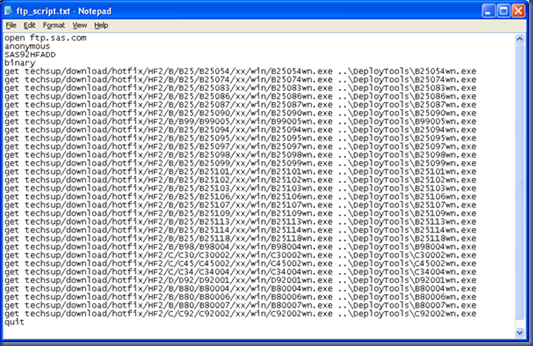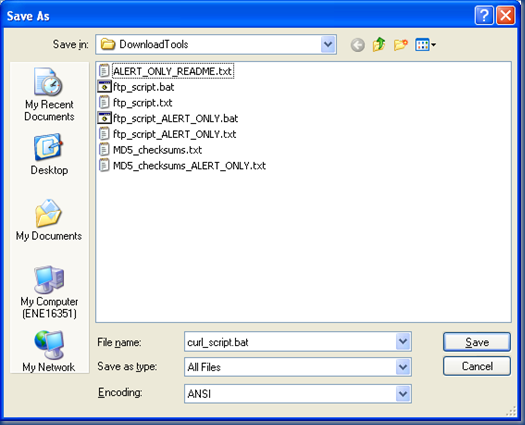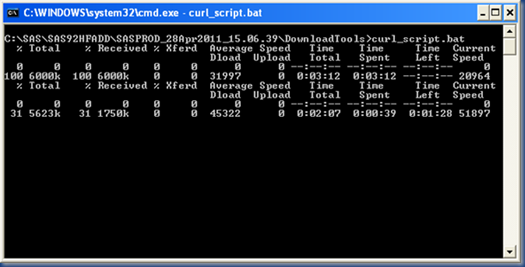My friend Leslie posted this comment as her Facebook status: “There are no answers, just the search.” At first I thought, “Now that is just silly. Of course there are answers.” Then I thought about it a little more. Maybe she is right. The Customer Sup…
Category: SAS
NOTE: Parameter Validation – %DATATYP
In yesterday’s article on coupling, I showed how the use of macro parameters can decouple your macros, making them more maintainable and reliable. Building-in some parameter validation is always a good practice too. Some simple, basic validation can so…
NOTE: Coupling, Bad
In my recent article on %MEND I said I didn’t like nested macro definitions. Some of my correspondents have suggested it’s a good means of keeping macro code near to where it’s called. I think this suggests a bad approach; namely, the i…
Using SAS92HFADD behind a “tough” firewall using CURL
As I have mentioned previously in Using SAS92HFADD behind a firewall, the SAS 9.2 Hot Fix Analysis, Download and Deployment tool is a great utility for the SAS Admin to help keep their SAS environment up to date with all the latest hot fixes from SAS. I routinely implement this as part of deploying SAS, and in most cases the tweaks I mention in my previous blog post are all that is needed. Unfortunately during one deployment I was faced with an outbound proxy/firewall that required Windows authentication…
The Problem
The organisation I was working with required all outbound internet traffic to pass through an authenticated proxy/firewall server. For normal internet access from a PC this all happens seamlessly via their Windows network. i.e. A user logs into their PC using their Windows credentials and then any network resource requiring authentication would negotiate using those credentials “behind the scenes” – probably using NTLM, SSPI or Kerberos. The SAS92HFADD tool uses the File Transfer Protocol (FTP) and the command line FTP client provided with Windows doesn’t support using proxy servers nor can it negotiate using NTLM, SSPI or Kerberos (that I know of). The solution that I chose was to use CURL – an open source command line tool for transferring files via a number of protocols (FTP, HTTP, etc.) that also supports proxies and authentication.
I have only done this on Windows servers, but I’m sure the same basic premise should work on Unix/Linix servers to get through a Windows based proxy/firewall as well.
Windows
1. Download the SAS92HFADD package
The download is a self extracting archive which when run will provide three files:
- SAS92HFADD.exe
- SAS92_hot_fix_data_ftp_download.bat
- SAS92_hot_fix_data_ftp_download_script.txt
2. Download CURL
CURL can be downloaded from http://curl.haxx.se/download.html. The CURL package that you download should have the SSPI option compiled into it. The package that I used was Win32 2000/XP 7.21.6 binary by Günter Knauf 1.32 MB.
3. Extract the CURLy bits
The CURL ZIP file that you downloaded has four files that you need to extract into the SAS92HFADD directory:
- curl.exe
- libcurl.dll
- libeay32.dll
- libssl32.dll

Your SAS92HFADD directory should look like this:
4. Modify SAS92_hot_fix_data_ftp_download.bat
Replace the entire contents of this file with the following single line:curl -U : -x internetproxy:8080 --proxy-ntlm -o SAS92_hot_fix_data.xml http://ftp.sas.com/techsup/download/hotfix/HF2/util01/SASHotFixDLM/data/SAS92_hot_fix_data.xml
internetproxy:8080 should be the name and port of your proxy server
5. Run SAS92HFADD.EXE
After adding the DeploymentRegistry.txt file into the sas92hfadd directory, the next thing I did was open a command prompt (cmd.exe), change into the sas92hfadd directory and execute the sas92hfadd program:
This will connect to SAS and do it’s magic, resulting in a time-stamped subdirectory containing the AnalysisReport, DownloadTools, DeploymentTools and Logs directories.
6. Modify ftp_script.txt
Navigate into the DownloadTools directory and you should find the following files:
Open ftp_Script.txt in your favourite text editor and get ready for some search + replace fun!
Here is my file before any changes:
The first string we want to find is: get techsup
This should be replaced with the following (changing internetproxy:8080 to your proxy and port): curl -U : -x internetproxy:8080 --proxy-ntlm http://ftp.sas.com/techsup
The above string is all one line.
The second string to change is:..\
This should be replaced with:-o ..\
There is a SPACE between “-o” and “..\”.
The next step is not a simple search and replace, but changing the first four lines of the file from:open ftp.sas.comanonymousSAS92HFADD@sas.combinary
to:@echo offset PATH=..\..;%PATH%
And finally, removing the last line that contains “quit”.
The final file looks like:
Now we can save this file as “curl_script.bat”
7. Download the Hot Fixes
Now we can execute the curl_script.bat file (instead of the ftp_script.bat file) to download our hot fixes.
8. BAU
From here on it is Business As Usual ![]()
The above is all “experimental” as I have only had to go to these lengths on one customer site – your mileage may vary, but I hope if you do come across this situation these steps will help you develop your own solution.
A New Look
If you’re a regular visitor to the NOTE: web site you’ll instantly notice that it looks different. NOTE:’s 2nd birthday is approaching (in July) so we thought it was time for a make-over. We’re pleased with the new, brighter appearance. Pleas…
Software Practice Advancement (BCS SPA)
I recently started a new contract in London. Having been based outside of London for the last couple of years, I’m being reminded of the benefits of working in the metropolis. One benefit is that I get to use public transport, thereby increasing my rea…
SAS Hits the Big Time
Recently, my mother handed me a copy of the May 2011 issue of Reader’s Digest magazine. Now, Reader’s Digest is not a magazine that I ordinarily read (though I confess to being a fan of its monthly Word Power vocabulary quiz), but this particular issue holds special interest. The article, Best of America, says that […]![]()
Global Airport Database Conversion Code
The Global Airport Database (GAD) lists the longitude / latitude in sexagesimal notation which makes it a pain to plot on any sort of map using a coordinate system. The following SAS code will convert the GAD and should result in file similar to airports.csv. data airports; infile ‘AirportDatabase.txt’ dsd dlm=’:’; input icao$ iata$ name$ […]
